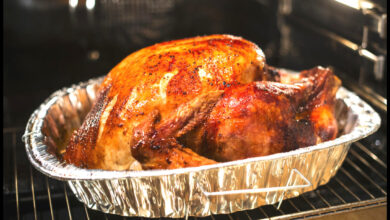Are milk and ground beef safe from bird flu? What the latest testing tells us.

Inactive bits of bird flu virus have found their way into some of the U.S. food and milk supply amid the latest outbreak of the disease in animals. It comes as the virus, also known as avian flu, continues to spread among a growing number of mammals, most pressingly, dairy cattle. While the reports may sound scary, experts say these fragments are not dangerous, and harmful versions of the virus are unlikely to wind up in anything people eat or drink.
Here’s what you need to know about bird flu and the safety tests being conducted on dairy, meat and more.
What’s going on with milk?
Tests conducted by the U.S. Food and Drug Administration (FDA) detected the genetic material, or RNA, of avian flu in about 20% of samples of commercially sold milk collected from across the country. Separate testing of a smaller number of milk cartons off grocery shelves by researchers at Ohio State University (OSU) and St. Jude’s Children’s Research Hospital found bird flu RNA fragments in about 39% of the 150 samples they tested.
“It definitely suggests to me that it’s more widespread than what we had given it credit for, but in some regard that’s not entirely unexpected,” Dr. Andrew Bowman, an associate professor of epidemiology and veterinary medicine at OSU, and co-author of the smaller milk study, tells Yahoo Life.
But the good news is that, along with the FDA’s testing, tests conducted by Bowman and his co-author, Richard Webby, a professor of infectious disease at St. Jude’s, have not found any samples with whole, or viable, avian flu virus. Small portions of the virus are not capable of causing an infection. Instead, Webby compares the testing of milk to on-screen detectives doing DNA testing at a crime scene: “They’re not necessarily looking for the virus itself, just the evidence that it’s been there at some stage,” Webby, who heads up the World Health Organization’s (WHO) initiative to study flu in birds and animals, tells Yahoo Life.
Samples of commercially sold milk found to contain virus fragments have been further tested to see if those bits of virus can grow in eggs or petri dishes, too, and so far, none of them have been able to do so. “If there was whole virus in a sample, it would replicate and we would find it, but we have not been able to find any,” Webby said. The FDA came to the same conclusion after running the same types of tests.
This is all evidence that pasteurization — the process used to sterilize milk — inactivates bird flu because it “breaks open the viral package,” Webby explains. Pasteurization is designed to kill all manner of viruses and bacteria and make milk safer. Unpasteurized, or raw, milk makes up less than 1% of the U.S. supply, and is banned in 23 states and the District of Columbia. The FDA advises against drinking it because it can lead to food poisoning.
With regular grocery store milk, there’s very little cause for concern at this point, according to Webby and Bowman.
What about other dairy products?
The FDA has also tested cottage cheese and sour cream for bird flu. Once again, the agency found noninfectious traces of the virus, but pasteurization had inactivated avian influenza in these products too.
Officials also tested baby formula and powdered milk derived from cows’ milk. The results were even better there: There was not a trace of virus in any of these products. FDA scientists concluded that no further testing was needed to prove that the products are safe.
Do I need to worry about eating beef?
The U.S. Department of Agriculture (USDA) declared the U.S. meat supply “safe” on May 1, according to Reuters. USDA officials tested 30 samples of ground beef collected in states where cattle herds have tested positive for bird flu. All of the samples tested negative for the virus.
While infections have not been reported among herds of cattle bred for use as meat, dairy cattle — among which bird flu has been spreading — are sometimes used for ground beef. Webby says that flu is unlikely to replicate in the muscle, but it’s unclear if it could in other parts of the animal that get processed into ground beef. Still, he says that the highest concentrations of bird flu have consistently been found in milk, and that safely handling and cooking beef — by not letting cross contamination happen in the kitchen, and cooking meat to an internal temperature of at least 145°F — should kill any viruses.
Are eggs a concern?
Bird flu has been found in egg-laying chickens, including those kept by Cal-Maine Foods, which is the largest manufacturer in the U.S. But the CDC says it’s unlikely that anyone would catch bird flu from eating eggs.
For one, you shouldn’t eat raw eggs, which can make you sick from other pathogens, like listeria. Like beef, cooking eggs to a proper temperature of 135°F to 165°F (depending on how you’re preparing them) should kill any bacteria or viruses, including bird flu.
Webby adds that bird flu is extremely fatal to chickens, so most that get infected will die, and farmers immediately cull any affected flocks, since only bird flu-free eggs and chickens can be sold in the U.S. and birds are regularly tested by regulators.




